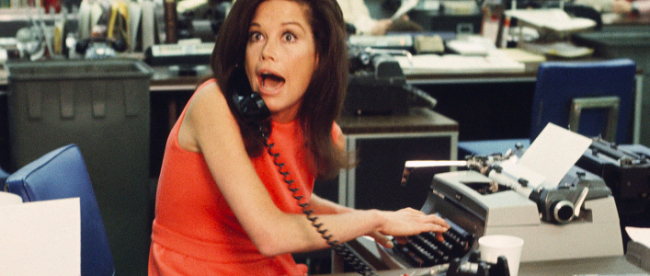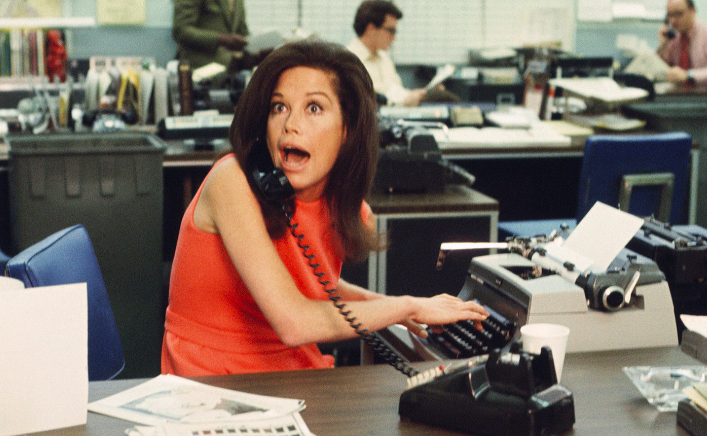When Fake News Became a Problem for Mary Tyler Moore


Mary Tyler Moore, above, was one of America’s most celebrated actresses. She came to fame for her role in The Dick Van Dyke Show and her own eponymous sitcom, The Mary Tyler Moore Show ran for seven seasons from 1970 to 1977 itself, earning 29 Emmy awards along the way. But her other shows didn’t go so well. She teamed up with CBS on two different variety shows — Mary in 1978 and then the Mary Tyler Moore Hour a year later — but both failed to make it to season two. In 1985, a second sitcom, confusingly named Mary, similarly bombed — it lasted 13 episodes.
It did, however, make one newspaper publisher very upset.
In Mary, Moore plays Mary Brenner, a divorced 40-something writer in Chicago with a fantastic pedigree but whose publisher, Women’s Digest, folded. In the opening credits, you see Brenner going door-to-door to the big name publishers in the city — the Tribune, the Sun-Times, etc. — all of which are newspapers in the real world. She gets nowhere and finally settles on taking an interview with a fictional newspaper which was originally named the Chicago Post, a local tabloid whose editor-in-chief believes salacious headlines and sensationalism is what makes the industry tick. Despite the newspaper’s exceptionally poor reputation, Brenner takes a job as a consumer affairs writer. What happens next on the show isn’t all that interesting, which is probably why it didn’t last.
But no one knew that at the time. The show’s producers put a good amount of marketing money behind its promotion, and in trying to drive interest for the TV show, the show’s marketing team had some fun with the character in their ad campaign, buying bus ads to promote the Chicago Post’s newest staff member. It worked, at least insofar as one passerby was concerned. Ken Levine, one of the show’s executive producers, explained what happened next: “I stayed back in Los Angeles during the filming and got a call from a gentleman who saw the bus ads. He identified himself as the editor of the Chicago Post.”
The Post wasn’t supposed to exist — as Levine says, the name “was cleared by [their] research company” as being not in use. Befuddled, Levine decided to do some investigating himself: “I hung up and called information and asked for the number of the Chicago Post. The operator gave it to me in a second.” Immediately, Levine knew he had a problem on his hand. The publisher of the newspaper didn’t take kindly to the fact that the name his newspaper — a neighborhood paper owned by a local politician — was being used to depict one of questionable journalistic ethics. So the real Chicago Post sued Mary seeking $4 million for the trouble.
That feels like a lot of money, especially given that Mary hadn’t yet debuted. But that’s because of how lawyers do math. While the real Chicago Post hadn’t suffered any meaningful damage from some bus ads, its legal team realized that Mary would have to spend a ton of money to remove the name of the paper from their show, which was due to air just a few days later. They figured that new sets would need to be made, new scripts written and shot, etc. — all stuff which would cost team Mary Tyler Moore a lot of money. A settlement would include a license to use the “Chicago Post” name, fixing that issue but at a windfall for the newspaper’s owners.
But they gambled wrong. Levine explains:
[The show’s producers, MTM Productions] offered a settlement, which was incredibly generous, but the paper held out for millions. They figured we had shot the pilot and would have to reshoot at a cost well into the millions. Well, the truth is, we had shot the pilot but the words Chicago Post were not visible in the newsroom. Fixing this problem was as simple as substituting the word “Eagle” in the mouths of those actors who originally said “Post” along with redoing a couple of shots for the opening titles. MTM gave them a deadline and said the offer was off the table if not accepted by the end of the business day. The Post figured we were bluffing and let the deadline go by.
When the two sides got in front of a judge, that decision to let that deadline pass proved to be a mistake. As the Chicago Tribune (a real newspaper) reported, once the MTM Productions promised to change the name of the fake newspaper before the show aired, the judge ruled in their favor; she was satisfied enough to take them at their word. She was right to do so as the producers were able to make the switch in time. Ultimately, the fake news beat the real one.
Bonus fact: In the sixth season of the Mary Tyler Moore Show, Betty Ford — the First Lady of the United States at the time — made a cameo, which you can see here. It’s the first time a sitting First Lady made an appearance on a sitcom.
From the Archives: All the News that’s Fit to Cage: How the New York Times fought to keep people from sharing newspapers.
